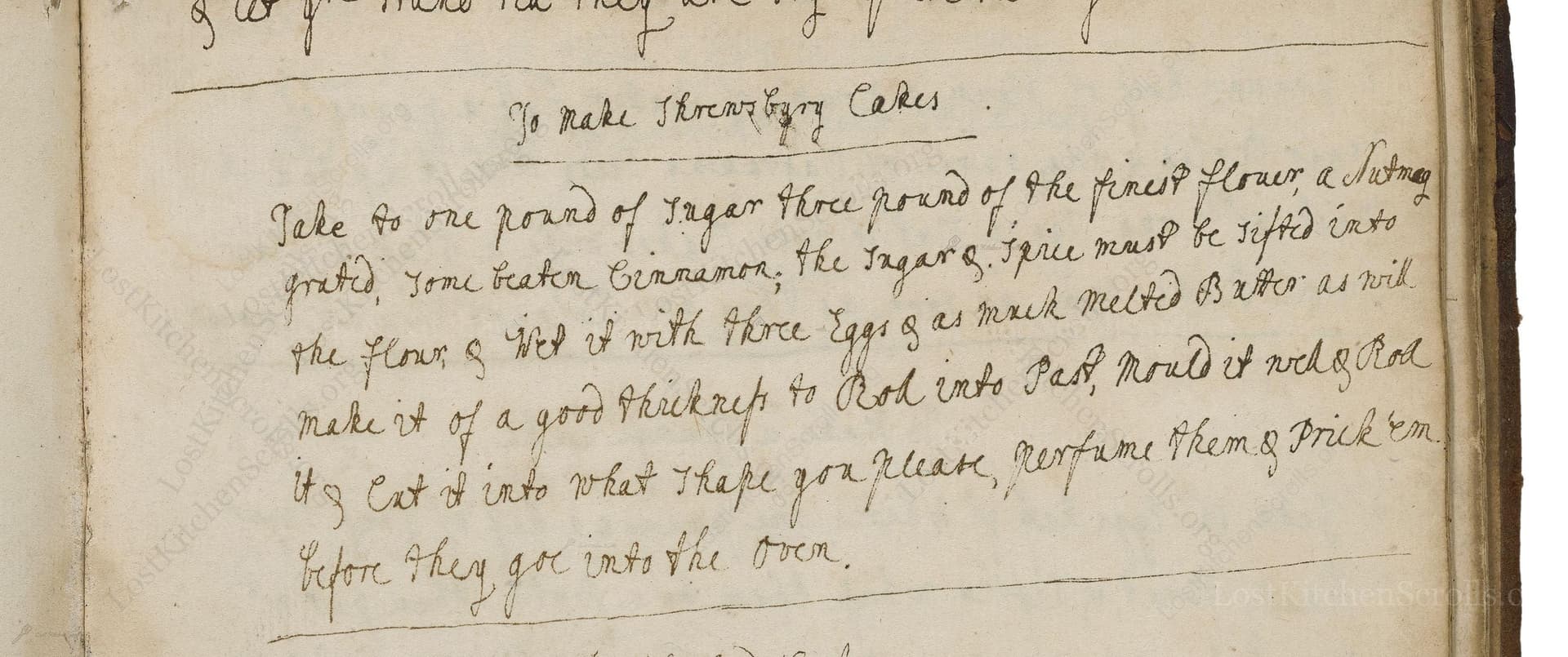To Make Throwzney Cakes
From the treasured pages of Receipt book of Elizabeth Smith
Written by Elizabeth Smith

To Make Throwzney Cakes
"Take To one pound of Sugar, three pound of the finest Flower, a Nutmeg grated, Some beaten Cinnammon, & Spice must be Sifted into the floar, & wet it with Three Eggs, & as much melted Butter as will make it of a good thickness To Rowl into Past, Mould it, & Rowl em & Cut it into what Shape you please, Perfume them, & Prick em before they goc into the Oven."
Note on the Original Text
The recipe is written in the informal, practical style of eighteenth-century household manuscripts: no specific baking times or quantities beyond major ingredients, assuming the cook’s familiarity with texture and consistency. Spelling reflects regional and phonetic variations ('flower' for flour, 'throwzney' likely an alternate or regional cake name). Directions are brief, emphasizing method over measurement, and the practice of sifting and using whole spices shows both attention and adaptation to available tools and tastes of the era.

Title
Receipt book of Elizabeth Smith (1775)
You can also click the book image above to peruse the original tome
Writer
Elizabeth Smith
Era
1775
Publisher
Unknown
Background
Step into the refined kitchens of the late 18th century with Elizabeth Smith, whose culinary wisdom offers a charming taste of Georgian elegance and time-honored recipes to delight any palate.
Kindly made available by
Folger Shakespeare Library
This recipe for Throwzney Cakes comes from the late Georgian period, dating approximately between 1749 and 1800, and is attributed to Elizabeth Smith. It originates from a time when home baking was common, and recipes were passed down in manuscript collections. The cakes would likely have been served at teatime or with ale. The inclusion of spice and perfume hints at their special-occasion status, as imported spices and floral waters were considered luxurious. Their precise name and form are somewhat mysterious, capturing the creative and regional spirit of eighteenth-century English baking.

In its era, this recipe would have been made with a large wooden bowl for mixing dough, a coarse flour sieve, and a butter pot for melting butter over the hearth. A large wooden board and a rolling pin would be required to roll out the dough. Shapes would be cut with a knife or shaped by hand. To 'prick' the cakes, a fork or skewer was used. Baking would occur in a wood-fired oven, stone bakehouse, or even on a metal baking sheet over coals.
Prep Time
20 mins
Cook Time
20 mins
Servings
40
We've done our best to adapt this historical recipe for modern kitchens, but some details may still need refinement. We warmly welcome feedback from fellow cooks and culinary historians — your insights support the entire community!
Ingredients
- 3 lb plain wheat flour
- 1 lb granulated sugar
- 1 whole nutmeg, grated
- 1–2 teaspoons ground cinnamon
- Pinch mixed spice (substitute: allspice, cloves, or mace as available)
- 3 large eggs
- 7–9 oz unsalted butter, melted
- Optional: a few drops rosewater or orange flower water
Instructions
- To make Throwzney Cakes today, begin by sifting together 3 lb of plain flour, 1 lb of granulated sugar, 1 whole grated nutmeg, and 1–2 teaspoons of ground cinnamon.
- You may also add a pinch of mixed baking spices (such as allspice or cloves) to taste.
- Make a well in the flour mixture and add 3 large eggs.
- Melt about 7–9 oz of unsalted butter and add enough to bring the mixture together into a firm but pliable dough that can be rolled.
- Turn the dough out onto a lightly floured surface, knead gently, then roll to about 3/8 inch thickness.
- Cut into any shapes you like—rounds, diamonds, or simple cookies.
- If desired, sprinkle lightly with rosewater or orange flower water to 'perfume' them, as was sometimes done.
- Prick the tops of each cake (small holes using a fork or skewer), and bake at 350°F (180°C) for about 15–20 minutes or until lightly golden.
Estimated Calories
170 per serving
Cooking Estimates
It will take about 20 minutes to prepare the ingredients and dough. Baking takes another 15–20 minutes. The recipe makes about 40 cakes, and each has about 170 calories.
As noted above, we have made our best effort to translate and adapt this historical recipe for modern kitchens, taking into account ingredients nowadays, cooking techniques, measurements, and so on. However, historical recipes often contain assumptions that require interpretation.
We'd love for anyone to help improve these adaptations. Community contributions are highly welcome. If you have suggestions, corrections, or cooking tips based on your experience with this recipe, please share them below.
Join the Discussion
Rate This Recipe

Den Bockfisch In Einer Fleisch Suppen Zu Kochen
This recipe hails from a German manuscript cookbook compiled in 1696, a time whe...

Die Grieß Nudlen Zumachen
This recipe comes from a rather mysterious manuscript cookbook, penned anonymous...

Ein Boudain
This recipe comes from an anonymous German-language manuscript cookbook from 169...

Ein Gesaltzen Citroni
This recipe, dating from 1696, comes from an extensive anonymous German cookbook...
Browse our complete collection of time-honored recipes



